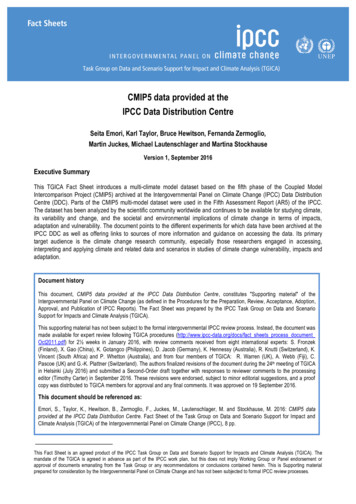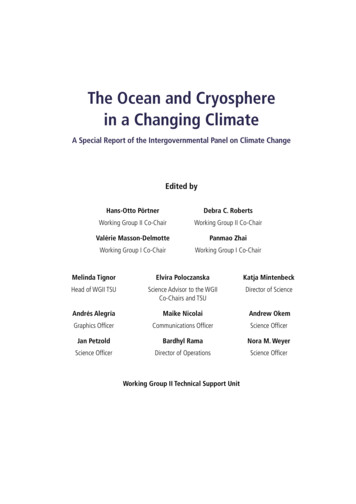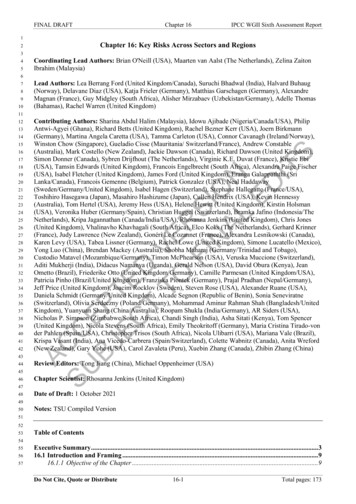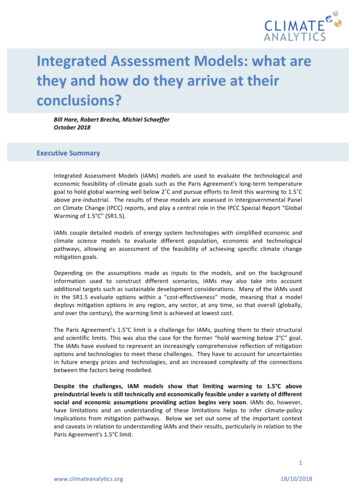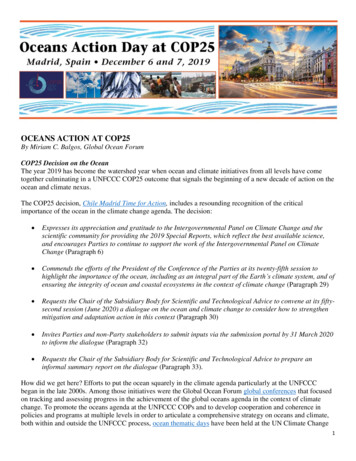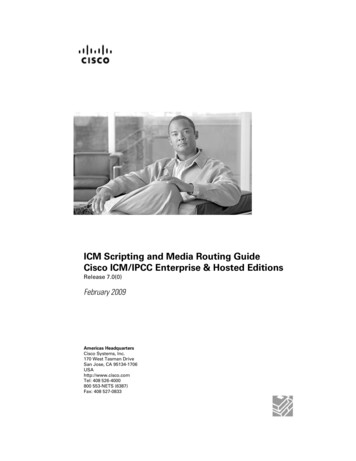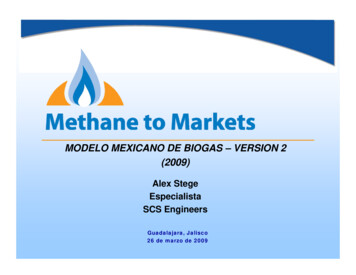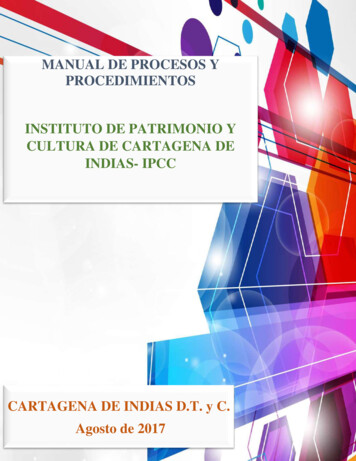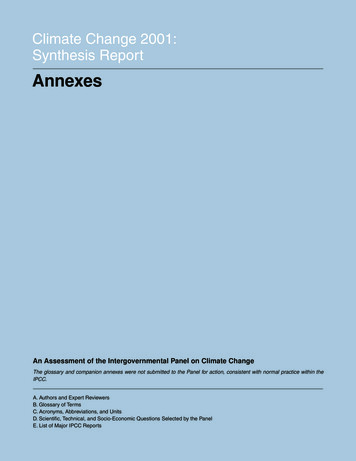
Transcription
Climate Change 2001:Synthesis ReportAnnexesAn Assessment of the Intergovernmental Panel on Climate ChangeThe glossary and companion annexes were not submitted to the Panel for action, consistent with normal practice within theIPCC.A. Authors and Expert ReviewersB. Glossary of TermsC. Acronyms, Abbreviations, and UnitsD. Scientific, Technical, and Socio-Economic Questions Selected by the PanelE. List of Major IPCC Reports
Climate Change 2001Synthesis ReportAnnex A. Authors and Expert Reviewers356ArgentinaDaniel BouilleMarcelo CabidoOsvaldo F. CanzianiRodolfo CarcavalloJorge O. CodignottoMartin de ZuviriaSandra Myrna DiazJorge FrangiHector GinzoOsvaldo GirardinCarlos LabragaGabriel SolerWalter VargasErnesto F. ViglizzoFundecion BarilocheIMBIV, University of CordobaCo-Chair, WGIIDepartment of EntomologyLaboratorio Geologia y Dinamica CosteraAeroterra S.A.Instituto Multidisciplinario de Biologia VegetalUniversidad Nacional de la PlataInstituto de NeurobiologiaFundacion BarilocheConsejo Nacional de Investigaciones Cientificas y Tecnicas, Centro Nactional PatagonicoFundacion Instituto Latinoamericano de Politicas Sociales (ILAPS)University of Buenos Aires - IEIMAPROCISUR/INTO/CONICETAustraliaSusan BarrellBryson BatesIan CarruthersHabiba GitayJohn A. ChurchOve Hoegh-GuldbergRoger JonesBryant McAvaneyChris MitchellIan NobleBarrie PittockAndy ReisingerB. SoderbaumGreg TerrillKevin WalshJohn ZillmanBureau of MeteorologyCSIROAustralian Greenhouse OfficeAustralian National UniversityCSIRO Division of OceanographyThe University of QueenslandCSIRO Atmospheric ResearchBureau of Meteorology Research CentreCSIRO Atmosphere ResearchAustralian National UniversityCSIRO (Climate Impact Group)Ministry for the EnvironmentGreenhouse Policy Office, Australian Greenhouse OfficeAustralian Greenhouse OfficePrincipal Research Scientist CSIRO Atmospheric ResearchVice-Chair, WGIAustriaRenate ChristHelmut HojeskyK. RadunskyIPCC SecretariatFederal Ministry for EnvironmentFederal Environment AgencyBangladeshQ.K. AhmadBangladesh Unnayan ParishadBarbadosLeonard NurseCoastal Zone Management UnitBelgiumPhilippe HuybrechtsC. VinckierR. ZanderVrije Universiteit BrusselDepartment of Chemistry, KULeuvenUniversity of LiegeBeninEpiphane Dotou AhlonsouMichel BokoService Météorologique NationalUniversite de BourgogneIPCC Third Assessment Report
Annex AAuthors and Expert ReviewersBosniaPermanent Mission of Bosnia & HerzegovinaBotswanaPauline O. DubeUniversity of BotswanaBrazilGylvan Meira FilhoJose Roberto MoreiraVice-Chair, IPCCBiomass User Network (BUN )CanadaBrad BassJames P. BruceMargo BurgessWenjun ChenJing ChenStewart J. CohenPatti EdwardsDavid EtkinDarren GoetzeJ. Peter HallH. HengeveldPamela KertlandAbdel MaaroudJoan MastertonChris McDermottBrian MillsLinda MortschTad MurtyPaul ParkerJohn RobinsonHans-Holger RognerDaniel ScottSharon SmithBarry SmitJohn StoneTana Lowen StrattonRoger StreetEric TaylorG. Daniel WilliamsEnvironment CanadaCanadian Climate Program BoardNatural Resources CanadaNatural Resources CanadaUniversity of TorontoEnvironment CanadaEnvironment CanadaEnvironment CanadaEnvironment CanadaCanadian Forest ServiceEnvironment CanadaNatural Resources CanadaEnvironment CanadaEnvironment CanadaEnvironment CanadaEnvironment CanadaEnvironment CanadaBaird and Associates Coastal EngineersUniversity of WaterlooUniversity of British ColumbiaUniversity of VictoriaEnvironment CanadaNatural Resources CanadaUniversity of GuelphVice-Chair, WGIDept. Foreign Affairs and International TradeEnvironment CanadaNatural Resources CanadaEnvironment Canada (retired)ChileE. BassoIndependent ConsultantChinaDu BilanZ. ChenLiu ChunzhenZhou DadiQin DaheXiaosu DaiLin ErdaMingshan SuYihui DingGuangsheng ZhouZ.C. ZhaoChina Institute for Marine Development StrategyChina Meteorological AdministrationHydrological Forecasting & Water Control CenterEnergy Research InstituteChina Meteorological AdministrationIPCC WGI TSUChinese Academy of Agricultural ScienceTsinghua UniversityCo-Chair, WGIChinese Academy of SciencesNational Climate Center357
Climate Change 2001358Synthesis ReportCubaRamon Pichs-MadrugaA.G. SuarezVice-Chair, WGIIICuban Environmental AgencyCzech RepublicJan PretelVice-Chair, WGIIDenmarkJesper GundermannKirsten HalsnaesErik RasmussenMartin StendelDanish Energy AgencyRiso International LaboratoryDanish Energy AgencyDanish Meteorological InstituteFinlandTimothy CarterP. HeikinheimoRaino HeinoPekka E. KauppiR. KorhonenA. LampinenI. SavolainenFinnish Environment InstituteMinistry of EnvironmentFinnish Meteorological InstituteUniversity of HelsinkiVTT EnergyUniversity of JyväskylaVTT EnergyFranceOlivier BoucherMarc DarrasJane EllisJean-Charles HourcadeJ.C. MorlotM. PetitUniversite de Lille IGaz de FranceOECDCIRED/CNRSEnvironment DepartmentEcole PolytechniqueGambiaB.E. GomezM. NjieDepartment of Water ResourcesDepartment of Water ResourcesGermanyHeinz-Jurgen AhlgrimmRosemarie BenndorfPeter BurschelUlrich CubaschU. FuentesJoanna HouseMaxJucundus JacobeitEberhard JochemHarald KohlPetra MahrenholzI. Colin PrenticeC. le QuéréSarah RaperFerenc TothManfred TreberR. SartoriusMichael WeberGerd-Rainer WeberInstitute for Technology & BiosystemsUmweltbundesamtTechnische Universitat MunchenMax Planck Institut für MeteorologieGerman Advisory Council on Global ChangePlanck Inst. BiogeochemieUniversitaet WuerzburgVice-Chair, WGIIIFederal Ministry of the EnvironmentFederal Environmental Agency of GermanyMax Planck Institute for BiogeochemistryMax Planck Institute for BiogeochemistryUniversity of East AngliaPotsdam Institute for Climate Impact ns Universität MünchenGesamtverband des Deutschen SteinkohlenberghausIPCC Third Assessment Report
Annex AAuthors and Expert ReviewersHungaryG. KoppanyHalldor ThorgeirssonUniversity of SzegedMinistry for the EnvironmentIndiaMurari LalRajendra K. PachauriN.H. RavindranathPriyadarshi ShuklaLeena SrivastavaIndian Institute of TechnologyTata Energy Research InstituteIndian Institute of SciencesIndian Institute of ManagementTata Energy Research InstituteIndonesiaR.T.M. SutamihardjaVice-Chair, WGIIIIsraelSimon KrichakTel Aviv UniversityItalyFilippo GiorgiAnnarita MariottiAbdus Salam International Centre for Theoretical Physics (ICTP)ENEA Climate SectionJapanKazuo AsakuraNoriyuki GotoMariko HandaHideo HarasawaYasuo HosoyaY. IgarashiTakeshi ImaiM. InoueHisashi KatoNaoki MatsuoHisayoshi MorisugiTsuneyuki MoritaShinichi NagataS. NakagawaYoshiaki NishimuraIchiro SadamoriAkihiko SasakiShojiro SatoA. TakeuchiKanako TanakaTomihiro TaniguchiCentral Research Institute (CRIEPI)University of Tokyo, KomabaOrganization for Landscape and Urban Greenery Technology DevelopmentSocial and Environmental Systems DivisionTokyo Electric Power CompanyMinistry of Foreign AffairsThe Kansai Electric Power Co., Inc.Ministry of Economy, Trade and IndustryCentral Research Institute of Electric Power IndustryGlobal Industrial and Social Progress Research Institute (GISPRI)Tohoku UniversityNational Institute for Environmental StudiesEnvironment AgencyJapan Meteorological AgencyCentral Research Institute of Electric Power IndustryGlobal Industrial and Social Progress Research Institute (GISPRI)National Institute of Public HealthChuba Electric Power Co.Japan Meteorological AgencyGlobal Industrial and Social ProgressVice-Chair, IPCCKenyaRichard S. OdingoKingiri SenelwaVice-Chair, WGIIIMoi UniversityMalawiPaul DesankerUniversity of VirginiaMexicoGustavo AlbinPermanent Representative Mission of Mexico359
Climate Change 2001360Synthesis ReportMoroccoAbdelkader AllaliAbdalah MokssitMinistry of Agriculture, Rural Development and FishingCentre National du Climat et de Recherchco MeteorologiquesNetherlandsAlphonsus P.M. BaedeT.A. BuishandW.L. HareCatrinus J. JepmaE. KoekkoekRik LeemansK. McKullenBert MetzLeo MeyerMaresa OostermanM.B.A.M. ScheffersRob SwartH.M. ten BrinkAad P. van UldenJ. VerbeekRoyal Netherlands Meteorological Institute (KNMI)Royal Netherlands Meteorological InstituteGreenpeace InternationalUniversity of GroningenMinistry of Housing, Spacial Planning and the EnvironmentNational Institute of Public Health and Environmental ProtectionGreenpeace InternationalCo-Chair, WGIIIMinistry of the EnvironmentMinisterie van Buitenlandse ZakenNational Institute for Coastal and Marine ManagementHead, WGIII TSUECNRoyal Netherlands Meteorological InstituteMinistry of Transport, Public Works and Water ManagementNew ZealandJon BarnettVincent GrayWayne HennessyPiers MaclarenMartin ManningHelen PlumeA. ReisingerJ. SalingerRalph SimsMacmillan Brown Centre for Pacific Studies, University of CanterburyClimate ConsultantCoal Research Association of New Zealand, Inc.NZ Forest Research InstituteVice-Chair, WGIIMinistry for the EnvironmentMinistry for the EnvironmentNational Institute of Water and Atmospheric Research Ltd (NIWA)Massey UniversityNigerGarba Goudou DieudonneOffice of the Prime MinisterNigeriaSani SamboAbubakar Tafawa Balewa UniversityNorwayTorgrim AspjellOyvind ChristophersenEirik J. ForlandS. GornasJarle Inge HoltenSnorre KverndokkA. MoeneAudun RosslandNils R. SaelthunTom SegalstadS. SundbyKristian TangenThe Norwegian Pollution Control AuthoritiesMinistry of EnvironmentNorwegian Meteorological InstituteUniversity of BergenTerrestrial Ecology ResearchFrischsenteret/Frisch CentreThe Norwegian Meteorological InstituteThe Norwegian Pollution Control AuthoritiesNorwegian Water Resources and Energy AdministrationUniversity of Oslom NorwayInstitute of Marine ResearchThe Fridtjof Nansen InstituteOmanMohammed bin Ali Al-HakmaniMinistry of Regional Municipalities, Environment & Water ResourcesIPCC Third Assessment Report
Annex AAuthors and Expert ReviewersPakistanTariq BanuriSustainable Development Policy InstitutePeruEduardo CalvoNadia GamboaVice-Chair, WGIIIPontificia Universidad Catolica del PeruPhillipinesLewis H. ZiskaInternational Rice Research InstitutePolandJan DobrowolskiZbyszek KundzewiczMiroslaw MietusA. OleckaM. SadowskiWojciech SuchorzewskiGoetel’s School of Environmental Protection & EngineeringPolish Academy of SciencesInstitute of Meteorology & Water ManagementNational Fund for Environmental Protection and Water ManagementNational Fund for Environmental Protection and Water ManagementWarsaw University of TechnologyRomaniaVasile CuculeanuAdriana MaricaNational Institute of Meteorology and HydrologyNational Institute of Meteorology and HydrologyRussiaYurij AnokhinOleg AnisimovIgor BashmakovIgor KarolAlla TsybanYuri IzraelInstitute of Global Climate & EcologyState Hydrological InstituteCentre for Energy Efficiency (CENEF)Main Geophysical ObservatoryInstitute of Global Climate and EcologyVice-Chair, IPCCSenegalAlioune NdiayeVice-Chair, WGIISierra LeoneOgunlade R. DavidsonCo-chair, WGIIISlovak RepublicMilan LapinComenius UniversitySouth AfricaGerrie CoetzeeBruce HewitsonSteve LennonRobert J. ScholesDepartment of Environmental Affairs and TourismUniversity of CapetownEskomCSIRSpainSergio AlonsoFrancisco Ayala-CarcedoLuis BalaironFelix HernandezDon Antonio Labajo SalazarMaria-Carmen LlasatJosep PenuelasAna YaberUniversity of the Balearic IslandsGeomining Technological Institute of SpainNational Meteorological InstituteCSICGovernment of SpainBotija University of BarcelonaCenter for Ecological Research & Forestry ApplicationsUniversity, Complutense of Madrid361
Climate Change 2001Sri LankaMohan MunasingheB. PunyawardenaVice-Chair, WGIIIDepartment of AgricultureSudanNagmeldin ElhassanHigher Coucil for Environment & Natural ResourcesSwedenMarianne LillieskoldUlf MolauNils-Axel MornerMarkku RummukainenSwedish Environmental Protection AgencyUniversity of GothenburgPaleogeophysics & Geodynamics Stockholm UniversitySwedish Meterorological and Hydrological InstituteSwitzerlandChristof AppenzellerFortunat JoosHerbert LangJosé RomeroT. StockerFederal Office of Meteorology and Climatology (MetroSwiss)Vice-Chair, WGISwiss Federal Institute of Technology Zurich (ETH)Office Federal de l’Environnement, des Forets et du PaysageUniversity of BernTanzaniaM.J. MwandosyaBuruhani S. NyenziCentre for Energy, Environment, Science, and TechnologyVice-Chair, WGIUnited KingdomNigel ArnellC. BakerTerry BarkerK. G. BeggS.A. Boehmer-ChristiansenRichard CourtneyK. DeyesThomas E. DowningCaroline FishChris FollandJonathan GregorySteve GregoryDavid GriggsJoanna HaighM. HarleySusan HaseldineJohn HoughtonMike HulmeMichael JeffersonCathy JohnsonSari KovatsDavid Mansell-MoullinAnil MarkandyaA. McCullochGordon McFadyenA.J. McMichaelAubrey MeyerJohn MitchellMartin Parry362Synthesis ReportIPCC Third Assessment ReportUniversity of SouthamptonNatural Environment Research CouncilUniversity of CambridgeUniversity of SurreyUniversity of HullThe LibertDepartment for Environment, Food and Rural AffairsEnvironmental Change InstituteUniversity of OxfordGlobal Atmosphere DivisionMet Office, Hadley CentreHadley Climate Research CentreForestry CommissionHead, WG-I TSUImperial CollegeEnglish NatureDepartment for Environment, Food and Rural Affairs (DEFRA)Co-Chair, WG-IUniversity of East AngliaWorld Energy CouncilIPCC, Working Group ILondon School of Hygiene and Tropical MedicineInternational Petroleum Industry Environmental Conservation Association (IPIECA)University of BathICI Chemicals & Polymers LimitedGlobal Atmospheric Division Deparment of the Environment, Transport and the RegionsLondon School of Hygiene and Tropical MedicineGlobal Commons InstituteHadley CenterJackson Environment Institute
Annex AAuthors and Expert ReviewersJ.M. PenmanS. RaperKeith ShineP. SingletonPeter SmithP. SmithsonPeter ThorneP. van der LindenDavid WarrilowPhilip L. WoodworthDepartment of the Environment, Transport and the RegionsUniversity of East AngliaDepartment of Meteorology, University of ReadingScottish Environment Protection AgencyIACR-RothamstedUniversity of SheffieldSchool of Environmental Sciences, University of East AngliaMet Office Hadley Centre for Climate Prediction and ResearchDepartment of the Environment, Food and Rural AffairsBidston ObservatoryUnited StatesDilip AhujaDan AlbrittonJeffrey S. AmthorPeter BacklundLee BeckLeonard BernsteinDaniel BodanskyRick BradleyJames L. BuizerJohn ChristySusan ConardCurt CoveyBenjamin DeAngeloRobert DickinsonDavid DokkenRayola DougherWilliam EasterlingJerry ElwoodPaul R. EpsteinPaul D. FarrarHoward FeldmanJosh FosterLaurie GellerMichael GhilVivien GornitzKenneth GreenDavid HarrisonDavid D. HoughtonMalcolm HughesStanley JacobsHenry D. JacobyJudson JaffeSteven M. JaparRussell O. JonesSally KaneT. KarlCharles KellerHaroon KheshgiAnn KinzigMaureen T. KoetzRattan LalChris LandseaNeil LearyNational Institute of Advanced StudiesNOAA Aeronomy LaboratoryOak Ridge National LaboratoryOffice of Science and Technology Policy/Environment DivisionU.S. Environmental Protection AgencyIPIECAU.S. Department of StateUS Department of EnergyNational Oceanic & Amtospheric AdministrationUniversity of AlabamaOffice of Science and Technology Policy/Environment DivisionLawrence Livermore National LaboratoryU.S. Environmental Protection AgencyUniversity of ArizonaUniversity Corporation for Atmospheric ResearchAmerican Petroleum InstitutePennsylvania State UniversityDepartment of EnegryHarvard Medical SchoolNaval Oceanographic OfficeAmerican Petroleum InstituteNOAA Office of Global ProgramsNational Research CouncilUniversity of California, Los AngelesColumbia UniversityReason Public Policy InstituteNational Economic Research AssociatesUniversity of Wisconsin-MadisonUniversity of ArizonaLamont-Doherty Earth Observatory of Columbia UniversityMassachusetts Institute of TechnologyCouncil of Economic AdvisersFord Motor CompanyAmerican Petroleum InstituteNOAANOAA National Climatic Data CenterIGPP.SIO.UCSDExxon Research & Engineering CompanyArizona State UniversityNuclear Energy InstituteOhio State UniverstiyNOAA AOML/Hurricane Research DivisionHead, WGII TSU363
Climate Change 2001364Synthesis ReportSven B. LundstedtAnthony LupoMichael C. MacCrackenJames J. McCarthyGerald MeehlRobert MendelsohnPatrick MichaelsEvan MillsWilliam MoomawBerrien MooreJames MorisonJennifer Orme-ZavaletaCamille ParmesanJ.A. PatzJoyce PennerRoger A. PielkeMichael PratherLynn K. Price LawrenceV. RamaswamyRobert L. RandallRichard RichelsDavid RindCatriona RogersMatthias RuthJayant SathayeMichael SchlesingerStephen SchneiderMichael J. ScottRoger SedjoWalter ShortJoel B. SmithRobert N. StavinsRon StoufferT. TalleyKevin TrenberthEdward VineHenry WalkerRobert WatsonHoward WesokyJohn P. WeyantTom WilbanksThe Ohio State UniversityUniversity of Missouri - ColumbiaU.S. Global Change Research ProgramCo-Chair, WGIINCARYale UniversityUniversity of VirginiaLawrence Berkeley National LaboratoryThe Fletcher School of Law and Diplomacy, Tufts UniversityUniversity of New HampshireUniversity of WashingtonUSEP/NHEERL/WEDUniversity of TexasJohns Hopkins UniversityUniversity of MichiganColorado State UniversityUniversity of California IrvineBerkeley National LaboratoryNOAAThe RainForest ReGeneration InstituteElectric Power Research InstituteNational Aeronautics and Space AgencyU.S. Global Change Research ProgramUniversity of MarylandLawrence Berkeley National LaboratoryUniversity of Illinois-Urbana-ChampaignStanford UniversityBattelle Pacific Northwest Nat’l LaboratoryResources for the FutureNational Renewable Energy LaboratoryStratus Consulting Inc.John F. Kennedy School of Government, Harvard UniversityUS Dept of Commerce/NOAAOffice of Global Change, U.S. Department of StateNCARLawrence Berkeley National LaboratoryU.S. Environmental Protection AgencyChair, IPCCFederal Aviation AdministrationEnergy Modeling Forum, Stanford UniversityOak Ridge National LaboratoryVenezuelaArmando Ramirez RojasVice-Chair, WGIZimbabweChris MagadzaM.C. ZinyoweraUniversity of ZimbabweMSU Zimbabwe GvtIPCC Third Assessment Report
Annex BAnnex B. Glossary of TermsThis Glossary is based on the glossaries published in the IPCCThird Assessment Report (IPCC, 2001a,b,c); however, additionalwork has been undertaken on consistency and refinement ofsome of the terms. The terms that are independent entries inthis glossary are highlighted in italics.AcclimatizationThe physiological adaptation to climatic variations.Activities Implemented Jointly (AIJ)The pilot phase for Joint Implementation, as defined in Article4.2(a) of the United Nations Framework Convention onClimate Change, that allows for project activity amongdeveloped countries (and their companies) and betweendeveloped and developing countries (and their companies).AIJ is intended to allow Parties to the United NationsFramework Convention on Climate Change to gain experiencein jointly implemented project activities. There is no creditingfor AIJ activity during the pilot phase. A decision remains tobe taken on the future of AIJ projects and how they may relateto the Kyoto Mechanisms. As a simple form of tradable permits,AIJ and other market-based schemes represent importantpotential mechanisms for stimulating additional resource flowsfor the global environmental good. See also CleanDevelopment Mechanism and emissions trading.AdaptabilitySee Adaptive capacity.AdaptationAdjustment in natural or human systems to a new or changingenvironment. Adaptation to climate change refers toadjustment in natural or human systems in response to actualor expected climatic stimuli or their effects, which moderatesharm or exploits beneficial opportunities. Various types ofadaptation can be distinguished, including anticipatory andreactive adaptation, private and public adaptation, andautonomous and planned adaptation.Adaptation assessmentThe practice of identifying options to adapt to climate changeand evaluating them in terms of criteria such as availability,benefits, costs, effectiveness, efficiency, and feasibility.Adaptation benefitsThe avoided damage costs or the accrued benefits followingthe adoption and implementation of adaptation measures.Adaptation costsCosts of planning, preparing for, facilitating, and implementingadaptation measures, including transition costs.Glossary of TermsAdaptive capacityThe ability of a system to adjust to climate change (including climatevariability and extremes) to moderate potential damages, to takeadvantage of opportunities, or to cope with the consequences.AdditionalityReduction in emissions by sources or enhancement of removalsby sinks that is additional to any that would occur in the absenceof a Joint Implementation or a Clean Development Mechanismproject activity as defined in the Kyoto Protocol Articles on JointImplementation and the Clean Development Mechanism. Thisdefinition may be further broadened to include financial,investment, and technology additionality. Under “financialadditionality,” the project activity funding shall be additionalto existing Global Environmental Facility, other financialcommitments of Parties included in Annex I, OfficialDevelopment Assistance, and other systems of cooperation.Under “investment additionality,” the value of the EmissionsReduction Unit/Certified Emission Reduction Unit shallsignificantly improve the financial and/or commercial viabilityof the project activity. Under “technology additionality,” thetechnology used for the project activity shall be the bestavailable for the circumstances of the host Party.Adjustment timeSee Lifetime; see also Response time.AerosolsA collection of airborne solid or liquid particles, with a typicalsize between 0.01 and 10 mm that reside in the atmospherefor at least several hours. Aerosols may be of either natural oranthropogenic origin. Aerosols may influence climate in twoways: directly through scattering and absorbing radiation, andindirectly through acting as condensation nuclei for cloudformation or modifying the optical properties and lifetime ofclouds. See indirect aerosol effect.AfforestationPlanting of new forests on lands that historically have notcontained forests. For a discussion of the term forest and relatedterms such as afforestation, reforestation, and deforestation,see the IPCC Special Report on Land Use, Land-Use Change,and Forestry (IPCC, 2000b).Aggregate impactsTotal impacts summed up across sectors and/or regions. Theaggregation of impacts requires knowledge of (or assumptionsabout) the relative importance of impacts in different sectors andregions. Measures of aggregate impacts include, for example, thetotal number of people affected, change in net primary productivity,number of systems undergoing change, or total economic costs.AlbedoThe fraction of solar radiation reflected by a surface or object,often expressed as a percentage. Snow covered surfaces have365
Climate Change 2001a high albedo; the albedo of soils ranges from high to low;vegetation covered surfaces and oceans have a low albedo.The Earth’s albedo varies mainly through varying cloudiness,snow, ice, leaf area, and land cover changes.Algal bloomsA reproductive explosion of algae in a lake, river, or ocean.AlpineThe biogeographic zone made up of slopes above timberlineand characterized by the presence of rosette-formingherbaceous plants and low shrubby slow-growing woodyplants.Alternative development pathsRefer to a variety of possible scenarios for societal valuesand consumption and production patterns in all countries,including, but not limited to, a continuation of today’s trends.In this report, these paths do not include additional climateinitiatives which means that no scenarios are included thatexplicitly assume implementation of the United NationsFramework Convention on Climate Change or the emissiontargets of the Kyoto Protocol, but do include assumptions aboutother policies that influence greenhouse gas emissionsindirectly.Alternative energyEnergy derived from non-fossil-fuel sources.Ancillary benefitsThe ancillary, or side effects, of policies aimed exclusively atclimate change mitigation. Such policies have an impact notonly on greenhouse gas emissions, but also on resource useefficiency, like reduction in emissions of local and regionalair pollutants associated with fossil-fuel use, and on issuessuch as transportation, agriculture, land-use practices,employment, and fuel security. Sometimes these benefits arereferred to as “ancillary impacts” to reflect that in some casesthe benefits may be negative. From the perspective of policiesdirected at abating local air pollution, greenhouse gasmitigation may also be considered an ancillary benefit, butthese relationships are not considered in this assessment.Annex I countries/PartiesGroup of countries included in Annex I (as amended in 1998)to the United Nations Framework Convention on ClimateChange, including all the developed countries in theOrganisation for Economic Cooperation and Development,and economies in transition. By default, the other countriesare referred to as non-Annex I countries. Under Articles 4.2(a)and 4.2(b) of the Convention, Annex I countries committhemselves specifically to the aim of returning individually orjointly to their 1990 levels of greenhouse gas emissions bythe year 2000. See also Annex II, Annex B, and non-Annex Bcountries.366IPCC Third Assessment ReportSynthesis ReportAnnex II countriesGroup of countries included in Annex II to the United NationsFramework Convention on Climate Change, including alldeveloped countries in the Organisation for EconomicCooperation and Development. Under Article 4.2(g) of theConvention, these countries are expected to provide financialresources to assist developing countries to comply with theirobligations, such as preparing national reports. Annex IIcountries are also expected to promote the transfer ofenvironmentally sound technologies to developing countries.See also Annex I, Annex B, non-Annex I, and non-Annex Bcountries/Parties.Annex B countries/PartiesGroup of countries included in Annex B in the Kyoto Protocolthat have agreed to a target for their greenhouse gas emissions,including all the Annex I countries (as amended in 1998) butTurkey and Belarus. See also Annex II, non-Annex I, and nonAnnex B countries/Parties.AnthropogenicResulting from or produced by human beings.Anthropogenic emissionsEmissions of greenhouse gases, greenhouse gas precursors,and aerosols associated with human activities. These includeburning of fossil fuels for energy, deforestation, and land-usechanges that result in net increase in emissions.AquacultureBreeding and rearing fish, shellfish, etc., or growing plantsfor food in special ponds.AquiferA stratum of permeable rock that bears water. An unconfinedaquifer is recharged directly by local rainfall, rivers, and lakes,and the rate of recharge will be influenced by the permeabilityof the overlying rocks and soils. A confined aquifer ischaracterized by an overlying bed that is impermeable andthe local rainfall does not influence the aquifer.Arid regionsEcosystems with less than 250 mm precipitation per year.Assigned amounts (AAs)Under the Kyoto Protocol, the total amount of greenhousegas emissions that each Annex B country has agreed that itsemissions will not exceed in the first commitment period (2008to 2012) is the assigned amount. This is calculated bymultiplying the country’s total greenhouse gas emissions in1990 by five (for the 5-year commitment period) and then bythe percentage it agreed to as listed in Annex B of the KyotoProtocol (e.g., 92% for the European Union, 93% for the USA).
Annex BAssigned amount unit (AAU)Equal to 1 tonne (metric ton) of CO2-equivalent emissionscalculated using the Global Warming Potential.AtmosphereThe gaseous envelop surrounding the Earth. The dry atmosphereconsists almost entirely of nitrogen (78.1% volume mixingratio) and oxygen (20.9% volume mixing ratio), together witha number of trace gases, such as argon (0.93% volume mixingratio), helium, and radiatively active greenhouse gases suchas carbon dioxide (0.035% volume mixing ratio) and ozone.In addition, the atmosphere contains water vapor, whoseamount is highly variable but typically 1% volume mixingratio. The atmosphere also contains clouds and aerosols.AttributionSee detection and attribution.BankingAccording to the Kyoto Protocol [Article 3(13)], Partiesincluded in Annex I to the United Nations FrameworkConvention on Climate Change may save excess emissionsallowances or credits from the first commitment period foruse in subsequent commitment periods (post-2012).BarrierA barrier is any obstacle to reaching a potential that can beovercome by a policy, program, or measure.BaselineThe baseline (or reference) is any datum against which changeis measured. It might be a “current baseline,” in which case itrepresents observable, present-day conditions. It might alsobe a “future baseline,” which is a projected future set ofconditions excluding the driving factor of interest. Alternativeinterpretations of the reference conditions can give rise tomultiple baselines.BasinThe drainage area of a stream, river, or lake.BiodiversityThe numbers and relative abundances of different genes(genetic diversity), species, and ecosystems (communities) ina particular area.BiofuelA fuel produced from dry organic matter or combustible oilsproduced by plants. Examples of biofuel include alcohol (fromfermented sugar), black liquor from the paper manufacturingprocess, wood, and soybean oil.BiomassThe total mass of living organisms in a given area or volume;recently dead plant material is often included as dead biomass.Glossary of TermsBiomeA grouping of similar plant and animal communities into broadlandscape units that occur under similar environmentalconditions.Biosphere (terrestrial and marine)The part of the Earth system comprising all ecosystems andliving organisms in the atmosphere, on land (terrestrialbiosphere), or in the oceans (marine biosphere), includingderived dead organic matter such as litter, soil organic matter,and oceanic detritus.BiotaAll living organisms of an area; the flora and fauna consideredas a unit.Black carbonOperationally defined species based on
P. Heikinheimo Ministry of Environment Raino Heino Finnish Meteorological Institute Pekka E. Kauppi University of Helsinki R. Korhonen VTT Energy A. Lampinen University of Jyväskyla I. Savolainen VTT Energy France Olivier Boucher Universite de Lille I Marc Darras Gaz de France Jane Ellis OECD Jean-Charles Hourcade CIRED/CNRS
